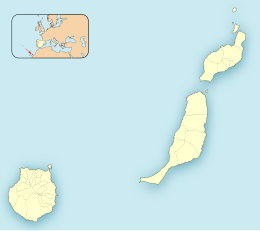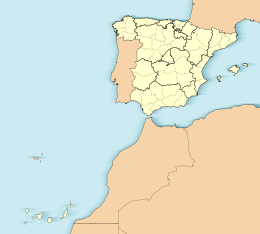
Back جراسيوسا (جزيره) ARZ La Graciosa AST Ла-Грасьёса Byelorussian La Graciosa Catalan Graciosa Island CEB Graciosa (Kanárské ostrovy) Czech La Graciosa German La Graciosa Esperanto La Graciosa Spanish Graciosa (Kanaari saared) Estonian
You can help expand this article with text translated from the corresponding article in Spanish. (May 2020) Click [show] for important translation instructions.
|
 La Graciosa from Mirador Del Río | |
| Geography | |
|---|---|
| Location | Atlantic Ocean |
| Coordinates | 29°15′00″N 13°30′29″W / 29.250°N 13.508°W |
| Archipelago | Chinijo Archipelago, Canary Islands |
| Area | 29.05 km2 (11.22 sq mi)[1] |
| Coastline | 30.395 km (18.8866 mi)[2] |
| Highest elevation | 266 m (873 ft) |
| Highest point | Agujas Grandes |
| Administration | |
| Autonomous Community | |
| Province | Las Palmas |
| Municipality | Teguise |
| Largest settlement | Caleta de Sebo (pop. 730) |
| Demographics | |
| Population | 734 (2018)[3] |
| Pop. density | 25.27/km2 (65.45/sq mi) |
| Languages | Spanish, specifically Canarian Spanish |
| Additional information | |
| Time zone | |
| • Summer (DST) | |
Graciosa Island or commonly La Graciosa (Spanish: [la ɣɾaˈsjosa] ⓘ; Spanish for "the graceful") is a volcanic island in the Canary Islands of Spain, located two kilometres (1+1⁄8 nautical miles) north of Lanzarote across the Strait of El Río. As the rest of the Canary Islands, it was formed by the Canary hotspot. The island is part of the Chinijo Archipelago and the Chinijo Archipelago Natural Park (Parque Natural del Archipiélago Chinijo).[4][5] It is administered by the municipality of Teguise in the neighboring island of Lanzarote. In 2018 La Graciosa was officially declared the eighth Canary Island by the Spanish Senate,[6] with few real effects.[7] Before then, the island had the status of an islet. It's administratively dependent on the island of Lanzarote.
The only two settlements on the island are Caleta de Sebo in the southeastern part of the island and summer-residence Casas de Pedro Barba; the rest of the island is owned by the Government of Spain and is administered by the National Parks Autonomous Agency.
The population is about 700. Tourism is the main industry along with fishing. Every year, tourists flock to the island for its tempered climate and its sandy volcanic coasts. The island has a school, lyceum, post office, supermarkets, medical center, pharmacy, a Bankia bank branch,[8] port, beaches, bar-restaurants and a square. Because of the transportation cost, everyday shopping is more expensive than in the other islands.[7]
Streets and roads on La Graciosa are unpaved sand. Motor vehicles are strictly limited to a handful of licensed vehicles for special purposes. Access to the island is by a 25-minute ferry crossing from Órzola on Lanzarote to the harbour in the village. There is a campsite on the island situated on Playa del Salado at the western edge of Caleta del Sebo.
- ^ "Estadística del Territorio" [Territory Statistics] (in Spanish). Instituto Canario de Estadística (ISTAC). Retrieved 2019-07-18.
- ^ "Longitud de costa de los islotes de Lanzarote" [Coastline length of the islets of Lanzarote] (in Spanish). Centro de Datos, Cabildo de Lanzarote. Retrieved 2019-07-18.
- ^ "Población de derecho de Teguise según unidad poblacional. Evolución (2000-2018)" [Legal population of Teguise by settlement. Evolution (2000-2018)] (in Spanish). Centro de Datos, Cabildo de Lanzarote. Retrieved 2019-07-18.
- ^ Protected Natural Areas Archived 2015-04-17 at the Wayback Machine
- ^ Boletín Oficial de Canarias, pages 9723 and 9865-7
- ^ Morris, Hugh. "Nine fascinating facts about the newest Canary Island". The Telegraph. Retrieved 2019-11-21.
- ^ a b Ferrera, Toni (7 November 2022). "La Graciosa, la isla canaria que logró su 'independencia' hace cuatro años sin mucho éxito". elDiario.es (in Spanish). Retrieved 7 November 2022.
- ^ "Bankia branch in CL THE TEGALA, 3 (Teguise)". bankia.es. Retrieved 2019-07-20.



